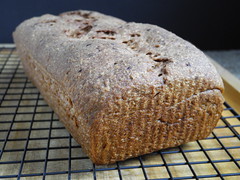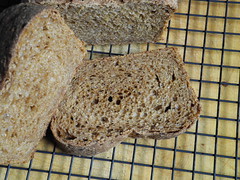
Next up in the BBA Challenge list is another sourdough rye--the third with one more to come (and one more non-sourdough rye as well). As the group 2011 Challenge seems to have fallen apart, I may re-arrange these last breads to an order more to my liking, avoiding 2 rye breads in a row, for example, and tackling the stollen over Christmas week. It's looking like I won't quite finish within 2011, but I do hope to have baked my way through the BBA by early 2012. I have 10 breads to go counting this one and 7 weeks in the year, but in there are the holidays, a business trip, and my annual Disney vacation week+ that eliminates 2 weekends of baking time. Yep, it'll be 2012 before I'm done, for sure.
The sourdough pumpernickel is an instant-yeast-assisted bread, using the sourdough starter for flavor. There's an option for pure sourdough, but I went for the faster and more reliable combination method. The bread is also not a 100% rye, using 2:1 bread flour to pumpernickel plus the flour in the starter, which in my case is probably mostly rye. The procedure is the familiar-by-now multi-day procedure: refresh the starter one day, make a rye starter with that, pumpernickel flour, and water and let it work for several hours before refrigerating it, then make the dough and bake the next day. For the dough, it's a mixture of the starter, bread flour, brown sugar, coloring to get the dark pumpernickel color--I had liquid caramel coloring, though coffee or cocoa powder are options, salt, instant yeast, fresh bread crumbs, oil, and water. All that is mixed quickly to not turn the rye flour gummy, then it rises for 2 hours. I decided to bake this one in a bread pan instead of using the hearth baking method--Reinhart gives directions for both.
The first rise went fine, if a little slow--I moved the dough into my warming drawer on "Proof" after an hour and a half and very liitle rise. (I've been adhering to Reinhart's instructions for long, slow, room temp rises most of the time.) I shaped the loaf and put it in a pan for the second rise, supposedly for 90 minutes or so. This time it went straight to the proofing drawer, but even after 2 hours the dough had barely crested the loaf pan. I went ahead and baked it after another 30 minutes, hoping for some oven spring, but alas, there was none and the loaf is a little flat.

Texture-wise, the bread is fine, with a nice crumb. It's not dense, rather belying what I think pumpernickel should be, but consider this a grocery store pumpernickel and it's perfectly OK: a little rye flavor, light textured, the right dark color (well, I see pumpernickels a lot darker, but this is in the range), but not a dense or chewy loaf. I ate one piece as a taster, part solo and part with herbs and oil, and had a little more as a wrapper for my Italian sausage at dinner. Having had that much, I don't think this bread warrants any more calories spent on it, so I'll see if the folks next door will take the rest of the loaf.
 The Tuscan bread was actually last weekend's project, before I left for Denver last Sunday. This weekend I backed up to the last of the sourdough breads, the Sunflower-Seed Rye. This one uses a soaker and a firm starter, which I made from my rye starter. However, I forgot to move the starter to the fridge overnight--perhaps that gives a little more sourdough tang to the bread, but as it's a yeast-assisted recipe I suspect the sourdough will be fairly muted.
The Tuscan bread was actually last weekend's project, before I left for Denver last Sunday. This weekend I backed up to the last of the sourdough breads, the Sunflower-Seed Rye. This one uses a soaker and a firm starter, which I made from my rye starter. However, I forgot to move the starter to the fridge overnight--perhaps that gives a little more sourdough tang to the bread, but as it's a yeast-assisted recipe I suspect the sourdough will be fairly muted. Not much to say about the process on this one: it didn't need much additional water and kneaded easily in the KitchenAid. I added maybe half again the called for sunflower seeds for extra crunch, and to use them up from the freezer. I didn't use a room-temperature rise, instead using the proof setting on my warming drawer to move things along. The loaf is shaped as a couronne or crown by making a boule, then working a hole in the middle to get a doughnut shape, then pressing down on that with a dowel (chopstick for me) in 4 places to get a very un-crown-like flattened circle-square, um, thing. Supposedly the dusting of flour over the dowel traces will prevent them from closing up during the rise, but just as when I tried this shape on the Pain de Campagne, the grooves mostly disappear. I tried a shallow slash down each of them before baking this time, which perhaps helped retain the shape a little, though nothing like the picture in BBA.
Not much to say about the process on this one: it didn't need much additional water and kneaded easily in the KitchenAid. I added maybe half again the called for sunflower seeds for extra crunch, and to use them up from the freezer. I didn't use a room-temperature rise, instead using the proof setting on my warming drawer to move things along. The loaf is shaped as a couronne or crown by making a boule, then working a hole in the middle to get a doughnut shape, then pressing down on that with a dowel (chopstick for me) in 4 places to get a very un-crown-like flattened circle-square, um, thing. Supposedly the dusting of flour over the dowel traces will prevent them from closing up during the rise, but just as when I tried this shape on the Pain de Campagne, the grooves mostly disappear. I tried a shallow slash down each of them before baking this time, which perhaps helped retain the shape a little, though nothing like the picture in BBA. The loaf got the hearth-baking technique with the oven temp dropped after the spritzing, then again after 10 minutes and the loaf rotation. Rather like my loaf of Tuscan bread, this loaf had more breadth than height, and was done after 10 minutes at the last temperature setting instead of 15. Results: nice texture, good chewy crust, and a mild rye/sourdough flavor.
The loaf got the hearth-baking technique with the oven temp dropped after the spritzing, then again after 10 minutes and the loaf rotation. Rather like my loaf of Tuscan bread, this loaf had more breadth than height, and was done after 10 minutes at the last temperature setting instead of 15. Results: nice texture, good chewy crust, and a mild rye/sourdough flavor.




